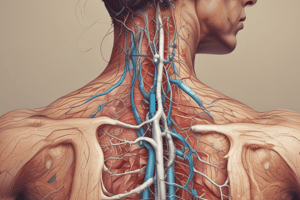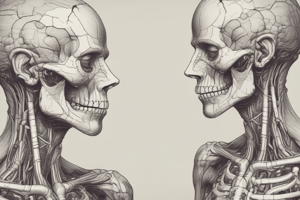Podcast
Questions and Answers
What is the function of the three bones in the inner ear?
What is the function of the three bones in the inner ear?
- To facilitate digestion
- To help in breathing
- To support the head and torso
- To transfer vibrations from the tympanic membrane to the inner ear (correct)
What is the laryngeal skeleton composed of?
What is the laryngeal skeleton composed of?
- Nine bones
- Three vertebrae
- Nine cartilages (correct)
- Five muscles
How many movable components are there in the spine?
How many movable components are there in the spine?
- 30
- 20
- 33
- 26 (correct)
What is the smallest bone in the human body?
What is the smallest bone in the human body?
What is the function of the spine?
What is the function of the spine?
How many ring-like bones are there in the spine?
How many ring-like bones are there in the spine?
What is the length of a typical myofiber?
What is the length of a typical myofiber?
How many types of muscle tissue are there in the human body?
How many types of muscle tissue are there in the human body?
What is the main function of skeletal muscles?
What is the main function of skeletal muscles?
What is the diameter of a typical myofiber?
What is the diameter of a typical myofiber?
What is the composition of myofibrils?
What is the composition of myofibrils?
How many muscles are approximately present in a typical male body?
How many muscles are approximately present in a typical male body?
What is the purpose of capillaries in muscle tissue?
What is the purpose of capillaries in muscle tissue?
What is the morphology of skeletal muscle tissue?
What is the morphology of skeletal muscle tissue?
What is the movement of lifting the foot called?
What is the movement of lifting the foot called?
What is the function of a synergist muscle?
What is the function of a synergist muscle?
What is the term for the muscle that has the major responsibility for a certain movement?
What is the term for the muscle that has the major responsibility for a certain movement?
What is the term for the compression of the median nerve in the wrist?
What is the term for the compression of the median nerve in the wrist?
What is the movement of turning the hand upward called?
What is the movement of turning the hand upward called?
What is the muscle that opposes or reverses a prime mover called?
What is the muscle that opposes or reverses a prime mover called?
What is the movement of turning the foot inward called?
What is the movement of turning the foot inward called?
What is the term for stabilizing the origin of a prime mover?
What is the term for stabilizing the origin of a prime mover?
What type of sweat glands become active at puberty?
What type of sweat glands become active at puberty?
Where are apocrine sweat glands typically found?
Where are apocrine sweat glands typically found?
What is the purpose of sweat in apocrine sweat glands?
What is the purpose of sweat in apocrine sweat glands?
What is characteristic of merocrine sweat glands?
What is characteristic of merocrine sweat glands?
What is the purpose of the lunula?
What is the purpose of the lunula?
What is the main factor in determining the severity of skin damage?
What is the main factor in determining the severity of skin damage?
What is the first step in skin repair?
What is the first step in skin repair?
What is necessary for skin regeneration to occur?
What is necessary for skin regeneration to occur?
What is the main function of the thoracic cage?
What is the main function of the thoracic cage?
How many vertebrae make up the vertebral column?
How many vertebrae make up the vertebral column?
What is the function of the facet joints in the spine?
What is the function of the facet joints in the spine?
What is the term for the bones that articulate directly to the sternum?
What is the term for the bones that articulate directly to the sternum?
What is the function of the laryngeal skeleton?
What is the function of the laryngeal skeleton?
What type of joints allow for full movement?
What type of joints allow for full movement?
What is the function of joints in the human body?
What is the function of joints in the human body?
What is the name of the bony structure that extends from the base of the skull to the pelvis?
What is the name of the bony structure that extends from the base of the skull to the pelvis?
Flashcards are hidden until you start studying
Study Notes
Apocrine Sweat Glands
- Made of dense, keratinized cells
- Become active at puberty
- Secrete sticky, cloudy sweat into hair follicles in armpits, around nipples, and in the pubic region
- Sweat is a food source for bacteria on skin, increasing odor
Merocrine Sweat Glands
- Also called eccrine sweat glands
- Very numerous with high numbers on soles and palms
- Coiled tubular structure secretes watery perspiration directly onto surface of skin
- Sweat also contains electrolytes, urea, and organic nutrients
- Sodium chloride gives it a salty taste
Repair of the Integument
- Skin regeneration occurs because stem cells of epithelium and connective tissue undergo cell division
- Replacing lost or damaged tissue
- Time depends on extent of damage
- Four steps of skin repair:
- Scab formation
- Tissue granulation
- Scab removal
Bones of the Inner Ear
- Located inside the petrous part of the temporal bone
- Three smallest bones of the body: Malleus, Incus, and Stapes (smallest bone in the body)
- These bones articulate with each other and transfer vibrations from the tympanic membrane to the inner ear
Laryngeal Skeleton
- Also known as the larynx or voice box
- Composed of nine cartilages
- Located between the trachea and the root of the tongue
- The hyoid bone provides an anchor point
- The laryngeal skeleton both opens and closes the glottis and regulates the degree of tension of the vocal folds, which produce vocal sounds when air is forced through them
Bones of the Vertebral Column
- The vertebral column is a flexible column formed by a series of 24 vertebrae, plus the sacrum and coccyx
- Commonly referred to as the spine
- Extends from the base of the skull to the pelvis
- Spinal joints do not have a wide range of movement, but they still allow the spine great flexibility
- Two facet joints help to prevent slippage and torsion
The Thoracic Cage
- Formed by the ribs and sternum
- Protects internal organs and gives attachment to muscles involved in respiration and upper limb movement
- The sternum consists of the manubrium, body of the sternum, and xiphoid process
- Ribs 1-7 are called true ribs because they articulate directly to the sternum
- Ribs 8-12 are known as false ribs
Joints in the Human Body
- Joints hold the skeleton together and support movement
- Types of joints:
- Immoveable joints
- Joints that allow a slight movement
- Joints allowing full movement
Muscle Tissue
- There are three main types of muscle tissue:
- Skeletal (striated or voluntary)
- Smooth
- Cardiac
- Skeletal muscle tissue is composed of long cells with a striated appearance
- Skeletal muscles attach to and move bones by contracting and relaxing in response to voluntary messages from the nervous system
Skeletal Muscle
- The typical male body contains approximately 640 muscles, which compose around two-fifths of its weight
- The same number in a female body make up a slightly smaller proportion
- Muscle fibers are organized into bundles supplied by blood vessels and innervated by motor neurons
Special Movements
- Dorsiflexion – lifting the foot
- Plantar flexion – depressing the foot
- Inversion – turn foot inward
- Eversion – turn foot outward
- Supination – hand facing upward
- Pronation – hand facing downward
- Opposition – touching thumb to other fingers
Types of Muscles
- Prime mover – muscle with the major responsibility for a certain movement
- Antagonist – muscle that opposes or reverses a prime mover
- Synergist – muscle that aids a prime mover in the same movement and helps prevent rotation or unwanted movement
- Fixator – stabilizes the origin of a prime mover so all tension can be used to move the insertion bone
Muscles of the Pelvis, Hip, and Thigh
- Muscles can lead to disorders of the muscular system
Muscles of the Lower Leg
- Carpal tunnel syndrome, also called median nerve compression, occurs when the tendons become inflamed, causing compression of the median nerve
- Symptoms include pain, numbness, and eventual weakness in the hand
Studying That Suits You
Use AI to generate personalized quizzes and flashcards to suit your learning preferences.




